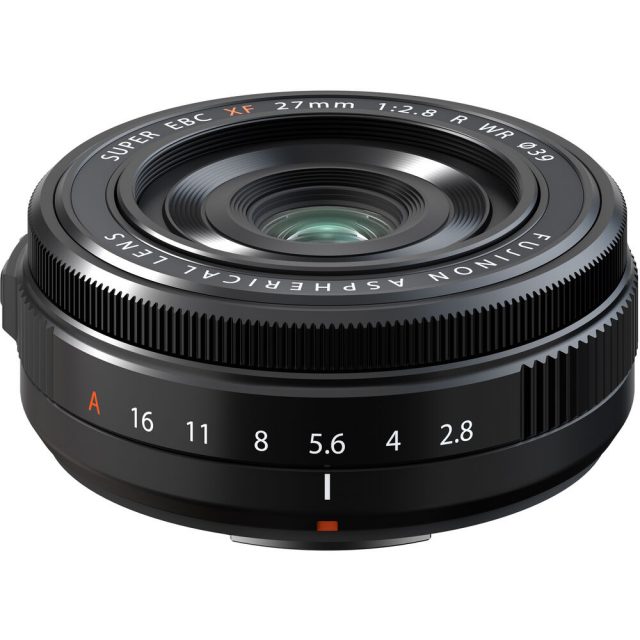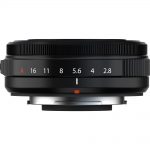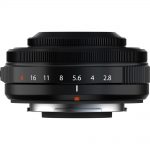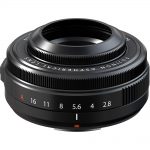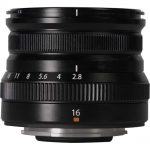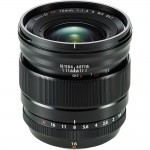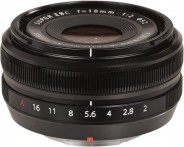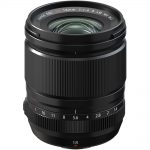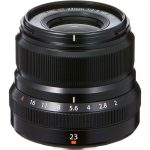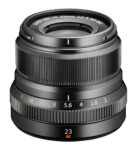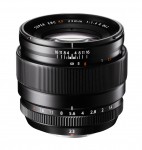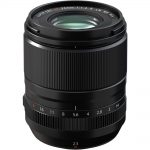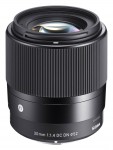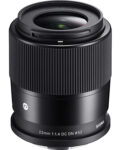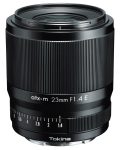Announced
Production status
Original name
System
Pros and cons
Genres or subjects of photography
Recommended slowest shutter speed when shooting static subjects handheld
Fujifilm Super EBC Fujinon XF 27mm F/2.8 Aspherical R WR
Wide-angle prime lens • Digital era
Abbreviations
| Super EBC | Multi-layer Super Electron Beam coating is applied to the surfaces of lens elements. This anti-reflection coating increases light transmission, eliminates flare and ghosting, and maintains color consistence among all lens models. |
| XF | The lens is designed for Fujifilm APS-C digital mirrorless cameras. |
| R | The lens is equipped with aperture ring. |
| WR | Dust-proof and Weather-Resistant lens. |
Model history
| ■Fujifilm Super EBC Fujinon XF 27mm F/2.8 Aspherical • Pancake lens | A | 7 - 5 | 0.60m | ⌀39 | 2013 ● | |
| ■Fujifilm Super EBC Fujinon XF 27mm F/2.8 Aspherical R WR • Pancake lens | A | 7 - 5 | 0.60m | ⌀39 | 2021 ● | |
Specification



| Optical design: | |
| 27mm | |
| F/2.8 | |
| APS-C | |
| Fujifilm X | |
| 55.6° (Fujifilm X APS-C) | |
| 7 elements in 5 groups | |
| 1 ASPH | |
| 35mm equivalent focal length and speed: | |
35mm equivalent focal length: | 41mm (in terms of field of view) |
35mm equivalent speed: | F/4.3 (in terms of depth of field) |
| Diaphragm mechanism: | |
Diaphragm type: | Automatic |
Aperture control: | Aperture ring (Manual settings + Auto Exposure setting) |
| 7 (seven) | |
| Focusing: | |
| 0.6m | |
| 0.34m (in MACRO mode) | |
| 1:10 | |
Focusing modes: | Autofocus, manual focus |
Autofocus motor: | Micromotor |
Manual focus control: | Focusing ring |
Focus mode selector: | None; focusing mode is set from the camera |
Manual focus override in autofocus mode: | Determined by the camera |
| Optical Image Stabilizer (OIS): | |
| - | |
| Physical characteristics: | |
| 84g | |
| ⌀62×23mm | |
| Dust-proof and water-resistant barrel | |
| - | |
| Accessories: | |
| Screw-type 39mm | |
| LH-XF27 - Screw-type dome-shaped | |
| Not compatible |
Source of data
- Manufacturer's technical data.
Manufacturer description
TOKYO, January 27, 2021 — FUJIFILM Corporation (President: Kenji Sukeno) is pleased to announce the launch of the “FUJINON Lens XF27mmF2.8 R WR” (XF27mmF2.8 R WR) in March 2021. It will be a new addition to the lineup of interchangeable XF lenses designed for X Series of mirrorless digital cameras, providing a compact lightweight design and outstanding image quality with Fujifilm's proprietary color reproduction technology.
The XF27mmF2.8 R WR is a standard prime lens with focal length of 27mm (equivalent to 41mm in the 35mm format). It offers outstanding resolution in a compact design. The dust and weather resistant structure provides durability and the aperture ring offers excellent operability so that users can enjoy high-quality photography in a wide range of shooting scenes including snapshots, portraits, and landscape photography.
The XF27mmF2.8 R WR has a focal length of 27mm (equivalent to 41mm in the 35mm format) and is highly versatile with the capability to depict subjects in a natural perspective. It has excellent resolution, which has received outstanding reviews with the previous model “FUJINON Lens XF27mm F2.8.” The XF27mmF2.8 R WR has the capability to capture subjects down to the finest detail. The compact design is the thinnest and lightest in the XF lens lineup* , weighing approximately 84g and just 23mm long. When mounted on the compact and lightweight mirrorless digital camera “FUJIFILM X-E4” which was also announced today, it offers high portability so the users can walk around and take photos with it. Operability and durability have been improved over the previous models thanks to the aperture ring which enables quick aperture value changes, a newly adopted dust and weather resistance and the ability to operate at low temperatures of down to -10℃. With this lens, users have the stability to continue shooting even in tougher environments such as in the light rain or harsh dusty outdoors.
Today, Fujifilm also announced the launch of super telephoto zoom lens “FUJINON Lens XF70-300mmF4-5.6 R LM OIS WR” (XF70-300mmF4-5.6 R LM OIS WR). With the XF27mmF2.8 R WR and XF70-300mmF4-5.6 R LM OIS WR joining extensive lens lineup, Fujifilm offers lenses that cover a wide range of focal lengths to complement photographic pleasure delivered by the X Series.
* Excluding the FUJINON Lens XF27mm F2.8 model discontinued with the launch of the new XF27mmF2.8 R WR.
1. Product features
(1) Excellent resolution in a compact design
- The XF27mmF2.8 R WR consists of seven lens elements in five groups, including one aspherical lens that controls spherical aberration, field curvature and distortion aberration to achieve astonishing image sharpness. It has high resolution from the fully open aperture to deliver sharp images capturing even the finest details of subjects.
- The focus system, which shifts the five elements of the lens front group, controls aberrations due to shooting distance. The XF27mmF2.8 R WR has a powerful DC motor delivering fast and accurate autofocus, making it easy for users to take high-quality photos.
- This latest addition to the XF lens lineup* has outstanding resolution in a compact design that is the thinnest and lightest weighing approximately 84g and 23mm long. It offers excellent portability and is easy to carry around while mounted on a mirrorless digital camera. The reassuring presence helps users encourage subjects to express themselves naturally for portraits and other photography.
(2) Aperture ring provides easy operability
- The XF27mmF2.8 R WR has an aperture ring with an F-stop scale. The aperture setting can be quickly checked and changed, indicating how effective this lens is for quick snapshots when settings must be aligned instantaneously.
- The A (auto) Position Lock** offers reliable operation, locking the aperture ring in place to avoid any unintentional adjustment during shooting.
** Turning the aperture ring from F16 to the A position, locks it in position. It will be unlocked by holding down the unlock button and turning from A position to F16.
(3) Highly robust performance
- The lens barrel is weather-sealed in seven points to ensure dust and weather resistance. It also operates at temperatures of down to -10℃. This lens enables to users to continue shooting outdoors even during a sudden rain.
Lens hood LH-XF27 and lens hood cap LHCP-27 (included in the package of XF27mmF2.8 R WR)
Together with the launch of the XF27mmF2.8 R WR, Fujifilm is also releasing the Lens Hood LH-XF27 and Lens Hood Cap LHCP-27 in March 2021, which support 39mm filter diameters.
Travellers' choice
- Fast speed (F/2.8)
- Very lightweight (84g) and very compact (23mm)
- Dust-proof and water-resistant barrel
Compared to other wide-angle prime lenses in the Fujifilm X system
- Slowest speed (F/2.8), along with 2 other models
- One of the longest closest focusing distances (0.6m)
- Smallest magnification (1:10), along with 2 other models
- One of the lightest (84g)
- Shortest length (23mm), along with the Super EBC Fujinon XF 27/2.8 Aspherical
- Pancake lens, along with the Super EBC Fujinon XF 27/2.8 Aspherical
- Smallest filter size (39mm), along with the Super EBC Fujinon XF 27/2.8 Aspherical
